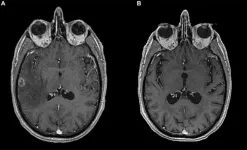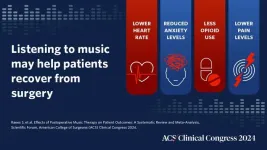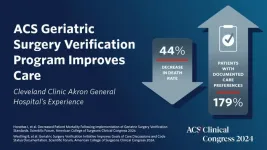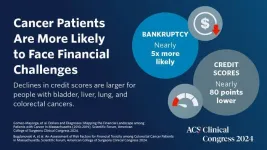(Press-News.org) "The perspective is enormous, because you’re taking something that is currently waste and making high-value products from it."
This is what Professor Per Halkjær Nielsen, Department of Chemistry and Bioscience at Aalborg University in Denmark, says about the results of a research project that utilizes surplus biomass in wastewater treatment plants in new ways. The focal point is biopolymers that can be described as long chains of molecules that are bound to each other and that are produced by living organisms, including bacteria. Today, synthetic polymers produced in the petrochemical industry from crude oil are used in many contexts including plastics, textile fibres, adhesives and paints. But with future production of biopolymers at wastewater treatment plants, it will be possible to extract a sustainable alternative to oil-based polymers through a waste product.
"In short, the work on biopolymers is about producing a lot of biomass in wastewater treatment plants that is actually bacteria that eat everything that enters the treatment plant so that only the pure water remains," explains Professor Per Halkjær Nielsen.
"Every single day, many tons of biomass are produced, depending on how big the treatment plant is, and this is typically converted in a biogas reactor so that you get energy out of it. A large part of the bacteria consists of biopolymers, i.e. the adhesive material around them, and biopolymers are in demand in the industry as a sustainable alternative to oil-based polymers."
Biopolymers can be used as a binding agent in paper and in building materials, and they can be used as a material for flocculation where small particles clump together and settle as part of the water purification of harbour sludge, lakes and wastewater treatment plants. An added bonus is that biopolymers from wastewater treatment plants appear to be fire-retardant. Thus, there is a potentially large market for biopolymers if they can be produced commercially in a sustainably way, and there is potential for this, according to the research project REThiNk.
In a wastewater treatment plant, there are several hundred different species of bacteria that produce many types of biopolymers with different properties. These bacteria use the biopolymers as an adhesive to form colonies and adhere to surfaces so they are not just flushed out of the treatment plant. These biopolymers can be extracted by changing the pH and temperature of the water to produce cellulose and gelatinous biopolymers that can be used for a variety of industrial products. The expectation is that it will be possible to create factories that produce biopolymers from Danish wastewater treatment plants, and the potential is great, since hundreds of thousands of tons of bacteria are produced annually in Denmark alone. As an added benefit, minerals and other valuable components can be harvested from the wastewater that arrives at the treatment plants, such as phosphorus which is on the EU's list of critical raw materials that may be difficult to obtain in the future.
The goal of the REThiNk project is to create the foundation for industrial scale-up in the short term so that in the long term there will be a real revolution in recycling biomass from wastewater treatment plants all over the world and not just in Denmark. It also requires mapping bacteria at wastewater treatment plants around the world so that it is possible to predict how each of them can play a role in biopolymer production, phosphorus extraction, etc.
"There is great potential if companies can see that the product can be used for something and thus want to invest in testing and developing it. And this requires that we build pilot scale plants so that we can produce not just grams, but kilograms and in a few years' time many tons. We can take 20-30 percent of the biomass and turn it into biopolymers that can replace petroleum products, but it actually also replaces seaweed. Today, many biopolymers are produced from seaweed from large kelp forests that are endangered. So if we can find other ways to extract biopolymers, it is a clear advantage for the environment and biodiversity as well," Per Halkjær Nielsen points out.
In the REThiNk project, Aalborg University is collaborating with Delft University in the Netherlands and Aarhus University, and the researchers have just published their results in the scientific journal Current Opinion in Biotechnology.
More information:
about the research project REThiNk (Recovery of extracellular polymers from wastewater treatment residuals as a new circular biopolymer): https://www.en.bio.aau.dk/research/projects/rethink
Article in the journal Current Opinion in Biotechnology, October 2024: "Rethinking characterization, application, and importance of extracellular polymeric substances in water technologies" (https://www.sciencedirect.com/science/article/pii/S0958166924001289)
About biopolymers: Polymers are substances that consist of molecules bonded to each other in long molecular chains. Biopolymers are formed by living organisms, one of the best known being cellulose from trees and plants. Synthetic polymers are artificially produced in the petrochemical industry based on crude oil and are used in plastics, textile fibres, adhesives and paints, among other things. The physical properties of polymers have an impact on what they can be used for (source: Lex.dk, https://denstoredanske.lex.dk/polymer).
Contact:
Per Halkjær Nielsen. Professor, Department of Chemistry and Bioscience and Director of the Center for Microbial Communities, Aalborg University. Tel: +45 21 73 50 89, Email: phn@bio.aau.dk
Morten Dueholm. Associate Professor, Department of Chemistry and Bioscience, Aalborg University. Tel: +45 99 40 85 08, Email: md@bio.aau.dk
Press Contact: Tor Bagger. Journalist, AAU Communication and Public Affairs. Tel: +45 30 17 31 65, Email: toba@adm.aau.dk
END
Materials of the future can be extracted from wastewater
A group of researchers is on the way to revolutionizing what biomass from wastewater treatment plants can be used for. Biopolymers from bacteria can be a sustainable alternative to oil-based products, and phosphorus and other minerals can also be harveste
2024-10-18
ELSE PRESS RELEASES FROM THIS DATE:
Long-lasting immunotherapy response in stage IV lung cancer with brain metastasis
2024-10-18
“In the last decade, immunotherapy agents changed the treatment landscape for Non-Small Cell Lung Cancer (NSCLC).”
BUFFALO, NY - October 18, 2024 – A new case report was published in Oncoscience (Volume 11) on October 8, 2024, entitled, “Complete and long-lasting response to immunotherapy in a stage IV non-small cell lung cancer with brain metastasis.”
As highlighted in the abstract of this report, approximately 20% of lung cancer patients have brain metastases at diagnosis, which is associated with a worse prognosis and negatively impacts quality ...
American lobster population, habitat preferences shifting, study finds
2024-10-18
American lobsters along Maine’s coast have relocated to new habitats, while the population simultaneously shrunk in abundance and grew older, according to a new study by University of Maine researchers.
For decades, the vast majority of adult lobsters resided in boulder shelter habitats. This knowledge helped inform longtime conservation efforts and regulations within the more than $740 million fishery.
A team of UMaine scientists, however, found that from 1995-2021, occupancy of boulder habitats dropped 60%. Meanwhile, the number ...
ASA invites media to virtual acoustics meeting Nov. 18-22
2024-10-18
MELVILLE, N.Y., Oct. 17, 2024 – The Acoustical Society of America is hosting a virtual meeting Nov. 18-22. Journalists are invited to virtually attend press conferences on Monday, Nov. 18 and attend technical sessions on Tuesday, Wednesday, and Thursday.
This scientific conference brings together interdisciplinary groups of acoustics professionals, spanning many fields, including physics, medicine, and music, to discuss the latest advancements. From dinosaurs to pipe organs, the virtual conference will cover a wide range of topics. Experts will present ...
Nonnative plants are a major force behind global insect invasions, new study finds
2024-10-18
In an article in the journal BioScience, an international team of researchers led by Dr. Cleo Bertelsmeier from the University of Lausanne, Switzerland, argue that the global spread of nonnative plants is a key factor driving the growing number of insect invasions worldwide. The research challenges traditional assumptions about the principal causes of nonnative insect invasions.
The authors note that when nonnative plants become established in new regions, they create ecological niches that permit the establishment of insect species from the plants' native ranges, which can produce further cascading effects: "Plant invasions ...
Listening to music may speed up recovery from surgery
2024-10-18
Key Takeaways
Music may have a calming effect on patients recovering from surgery– reducing anxiety, perceived pain, and heart rate.
A reduction in cortisol levels when listening to music may play a role in easing patients’ recovery.
Looking for a creative way to quicken your recovery from surgery? The key may be found in listening to music, according to research presented at the American College of Surgeons (ACS) Clinical Congress 2024 in San Fransisco, California.
Researchers at California Northstate ...
Emotional and financial concerns of breast cancer patients are often unmet
2024-10-18
Key Takeaways
Analysis of Reddit posts shows that many breast cancer patients often struggle with multiple emotional and financial concerns during treatment and long after.
There is a need for increased access to education and workshops on coping, treatment decision-making, and understanding diagnoses and prognoses.
Although breast cancer is the most common non-skin cancer diagnosed in women, finding support during treatment and through survivorship can be incredibly challenging. An analysis of posts from breast cancer patients on the ...
ACS program cuts surgical deaths and improves care for older adults, studies show
2024-10-18
Key Takeaways
The American College of Surgeons Geriatric Surgery Verification program is a quality-improvement program aimed at improving the care of older adult patients. The program consists of 32 evidence-based standards.
The death rate after surgery was reduced by nearly half — from 10.2% to 5.7% — at one hospital after implementing the ACS GSV program standards.
The proportion of patients with documented care preferences, including advanced-care directives, nearly tripled after implementing the program standards.
Implementing ...
Cancer diagnoses linked to lasting financial challenges, studies find
2024-10-18
Key Takeaways
Cancer patients are nearly 5 times more likely to experience bankruptcy.
Studies are the first to use objective data to evaluate the financial fallout for patients with cancer.
For patients with bladder, liver, lung, and colorectal cancers, the impact on credit scores was larger compared with other types of cancers.
A diagnosis of cancer can take a toll on more than a person’s health. Researchers at Beth Israel Deaconess Medical Center and Harvard Medical School in Boston found that financial fallout can follow patients with cancer ...
Groundbreaking surgical technique makes combined face and whole-eye transplantation a reality
2024-10-18
Key Takeaways
The world's first combined face and whole-eye transplantation used personalized surgical cutting guides and a novel “shortcut” to maintain blood flow to the transplanted eye.
Innovative surgical techniques ensured optimal blood flow to the retina, safeguarding the viability of the transplanted eye during the procedure.
An explanation of how an NYU Langone Health surgical team performed the world’s first combined face and whole-eye transplantation will be presented at the American ...
Bariatric surgery is more cost effective than newer weight loss drugs alone
2024-10-18
Key Takeaways
Two new studies shed light on the costs associated with newer weight loss drugs and their use before bariatric surgery.
Long term, the cost effectiveness of bariatric surgery is greater than that of GLP-1 RA weight loss drugs alone, but a combination of the two treatments is more cost effective than surgery alone.
Taking GLP-1 RA weight loss drugs in the year before bariatric surgery is not linked to worse health outcomes within one month after surgery, or significantly different weight loss one year after the operation.
Newer ...
LAST 30 PRESS RELEASES:
Researchers find promising new way to boost the immune response to cancer
Coffee as a staining agent substitute in electron microscopy
Revealing the diversity of olfactory receptors in hagfish and its implications for early vertebrate evolution
Development of an ultrasonic sensor capable of cuffless, non-invasive blood pressure measurement
Longer treatment with medications for opioid use disorder is associated with greater probability of survival
Strategy over morality can help conservation campaigns reduce ivory demand, research shows
Rising temperatures reshape microbial carbon cycling during animal carcass decomposition in water
Achieving ultra-low-power explosive jumps via locust bio-hybrid muscle actuators
Plant-derived phenolic acids revive the power of tetracycline against drug-resistant bacteria
Cooperation: A costly affair in bacterial social behaviour?
Viruses in wastewater: Silent drivers of pollution removal and antibiotic resistance
Sub-iethal water disinfection may accelerate the spread of antibiotic resistance
Three in four new Australian moms struggle with body image
Post-stroke injection protects the brain in preclinical study
Cardiovascular risk score predicts multiple eye diseases
Health: estimated one in ten British adults used or interested in GLP-1 medications for weight loss
Exercise to treat depression yields similar results to therapy
Whooping cough vaccination for pregnant women strengthens babies’ immune system
Dramatic decline in new cases of orphanhood in Uganda driven by HIV treatment and prevention programs
Stopping weight loss drugs linked to weight regain and reversal of heart health markers
Higher intake of food preservatives linked to increased cancer risk
Mass General Brigham–developed cholera vaccine completes phase 1 trial
First experimental validation of a “150-year-old chemical common sense” direct visualization of the molecular structural changes in the ultrafast anthracene [4+4] photocycloaddition reaction
Lack of support for people on weight loss drugs leaves them vulnerable to nutritional deficiencies, say experts
Dogs’ dinners can have greater climate impact than owners’
Are you ready to swap salmon for sprats and sardines?
1.6 million UK adults used weight loss drugs in past year
American College of Cardiology comments on new dietary guidelines for Americans
American Society of Gene & Cell Therapy and Orphan Therapeutics Accelerator partner to advance and commercialize promising rare disease treatments
One in 14 patients having day case surgery have new or worse chronic pain 3 months after their operation
[Press-News.org] Materials of the future can be extracted from wastewaterA group of researchers is on the way to revolutionizing what biomass from wastewater treatment plants can be used for. Biopolymers from bacteria can be a sustainable alternative to oil-based products, and phosphorus and other minerals can also be harveste







